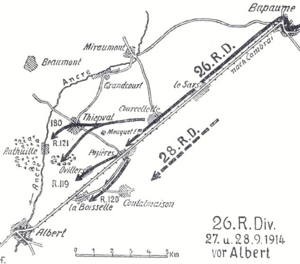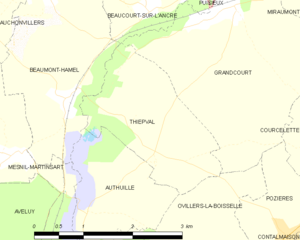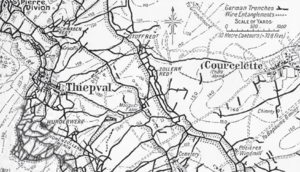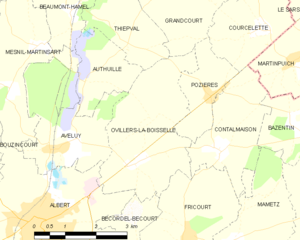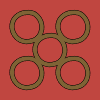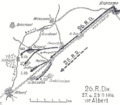Leipzig Salient facts for kids
Quick facts for kids Leipzig Salient |
|||||||
|---|---|---|---|---|---|---|---|
| Part of The Battle of the Somme, First World War | |||||||
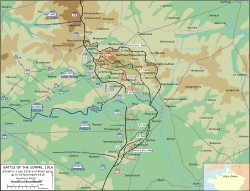 Battle of the Somme 1 July – 18 November 1916 |
|||||||
|
|||||||
| Belligerents | |||||||
| Commanders and leaders | |||||||
| Douglas Haig | Erich von Falkenhayn | ||||||
The Leipzig Salient was a German army position during the First World War. It was built in 1915 on the Somme battlefield in France. This area was near the village of Authuille. The Germans had a strong point called the Leipzig Redoubt within this position.
This important spot was south-west of the Thiepval Memorial site. It was also near key crossroads. The German front line curved around a quarry. This quarry was heavily fortified. Another strongpoint, called the Wundtwerk (Wonderwork by the British), was also nearby. To the east was Nab Valley. The village of Thiepval was to the north. Further north-east were Mouquet Farm and the village of Pozières, both fortified.
On the First day on the Somme (1 July 1916), British troops attacked the Leipzig Salient. The 1/17th Highland Light Infantry (17th HLI) led the attack. They moved forward just before the British artillery barrage lifted. The Scots quickly captured the redoubt. They surprised the German soldiers hiding in their dugouts. The 17th HLI tried to advance further but were pushed back. They held their ground at the Leipzig Redoubt.
Other British units joined them at the redoubt. These included the 11th Border Regiment and the 1st Dorset Regiment. The 19th Lancashire Fusiliers also helped. The 17th HLI was pulled out that night. Fighting continued in July. British divisions took turns holding the Leipzig Redoubt. They tried to push forward and stop the Germans from moving troops. Both sides suffered heavy losses. Operations at the Leipzig Salient continued during the Battle of Pozières and the Battle of Thiepval Ridge.
Why Was This Area Important?
The War in 1914
In September 1914, German forces attacked towards Albert and Thiepval. Thiepval was taken without a fight. However, French troops had dug in at Thiepval Wood. They also blocked river crossings with barbed wire. A German attack on Authuille was stopped. French counter-attacks pushed some German companies back.
German Defenses on the Somme
In 1915, Germany built strong defenses on the Somme front. Barbed wire fences became much wider and thicker. The front line grew from one trench to three. These trenches were 150–200 yards apart. The first trench had sentries. The second held most of the soldiers. The third was for local reserves.
Dugouts were made much deeper, from 6–9 feet to 20–30 feet. They were large enough for 25 men. An intermediate line of strong points was built about 1,000 yards behind the front. Communication trenches led back to a second defensive position. This second position was also very strong. It was placed far enough back to be out of range of Allied field artillery. This forced attackers to move their guns forward.
After battles in late 1915, a third defensive line was started in February 1916. It was almost finished when the Somme battle began. German artillery was organized into "barrage sectors." Each officer knew which batteries covered his part of the front. A telephone system connected the front line to the artillery. The phone lines were buried 6 feet deep for 5 miles.
However, the Somme defenses had weaknesses. The front trenches were on a forward slope. The white chalk from digging made them easy to see. Troops were also crowded near the front. This meant they would face the full force of an artillery attack.
The Leipzig Salient: A Key Stronghold
The German defenses included a redoubt south of Thiepval. The British called it the Leipzig Salient. It was a bulge in the German line around an old chalk quarry. South-west of it were important crossroads and more defenses. These included Hindenburg Trench and Lemberg Trench. The Wundtwerk (Wonderwork) was also dug behind the redoubt.
Nab Valley was to the east. Thiepval was to the north. Mouquet Farm, a fortified position, was to the north-east near Pozières. The Leipzig Salient blocked the way to the Schwaben Redoubt. This redoubt was on a ridge and controlled the area. The Wonderwork was an irregular trench network higher up the spur. It, along with other fortified places, controlled the approaches to the Leipzig Salient.
Getting Ready for Battle
German Preparations
The German front line facing the British X Corps was held by eight battalions. These were mainly from the 26th Reserve Division. The Leipzig Salient defenses were held by parts of Reserve Infantry Regiment 99. Their headquarters were in Mouquet Farm. Thiepval was held by Infantry Regiment 180.
The German defenses were mostly on higher ground. However, some areas were hidden from view. Authuille and Thiepval woods, along with Aveluy Wood, hid British troop movements. This allowed British soldiers to gather unseen for the attack.
Thiepval village was opposite the center of the British X Corps. It was on a spur within the German front line. Most of the village was destroyed by British shelling. But the house cellars were protected by rubble. German machine-gun positions were not hit. Shelters under the village protected the soldiers. They also kept ammunition and machine-guns safe. A line of cellars on the west side of the village was linked. This formed a strong line of machine-gun posts. These guns could sweep the slopes of Thiepval Spur. They could also fire on attacks further south. South of Thiepval was the Leipzig Redoubt. It had many machine-guns. These guns controlled the open ground (no man's land) in front.
In the German third trench line, four fortified positions were built. The Wonderwork was behind the Leipzig Redoubt. It was hidden from British view. It was meant to stop any advance if the front trenches were taken. Another redoubt was built behind Thiepval. The Schwaben Redoubt was on top of Bazentin Ridge. It overlooked the village and the ridge. Further north, St Pierre Divion anchored the first position. An attack on the Leipzig Salient could be hit by machine-guns from the Nordwerk. This was on Ovillers Spur, across Nab Valley.
British Preparations
| Date | Rain mm |
°F | |
|---|---|---|---|
| 23 | 2.0 | 79°–55° | wind |
| 24 | 1.0 | 72°–52° | dull |
| 25 | 1.0 | 71°–54° | wind |
| 26 | 6.0 | 72°–52° | dull |
| 27 | 8.0 | 68°–54° | dull |
| 28 | 2.0 | 68°–50° | dull |
| 29 | 0.1 | 66°–52° | dull wind |
| 30 | 0.0 | 72°–48° | dull rain |
The British 49th (West Riding) Division was held in reserve. It was ready to move forward. Bridges and causeways were built over the Ancre river. The X Corps had many heavy guns and howitzers. They also had many field guns. The artillery was well protected in dugouts. There was a heavy gun for every 57 yards of front. A field gun was placed every 28 yards.
The British planned a detailed artillery bombardment. Heavy howitzers would lift their fire early. The 18-pounder guns would "search" from trench to trench. The 4.5-inch howitzers would hit strong points. The bombardment would lift from the German front trench at zero hour. It would then move to the reserve line. British observers had good views from nearby spurs and woods. They believed the wire was well cut at the Leipzig Redoubt. Assembly trenches were dug just before the attack. This tired out many of the attacking troops.
British Attack Plan
The British X Corps aimed to capture the Thiepval Spur. This would give them a view over German positions. Both British divisions practiced on trenches that looked like the German defenses. The 32nd Division would attack the Leipzig Salient and Thiepval village. A cloud gas attack was planned just before the main bombardment. The division would gather on the Thiepval Spur.
The 97th Brigade would attack the Leipzig Salient. The 17th and 16th battalions of the Highland Light Infantry (HLI) would lead. The 2nd Battalion, King's Own Yorkshire Light Infantry (2nd KOYLI) would support them. The 17th HLI would advance close to the German trench. They would rush it when the artillery lifted. Once the redoubt was captured, the 11th Battalion, Border Regiment would clear the defenses. Then, the 97th Brigade would advance towards Mouquet Farm. After capturing the Wonderwork, Thiepval village, and Schwaben Redoubt, both divisions would attack the German intermediate position.
The Battle Begins
July 1st: The Main Attack
| Date | Rain mm |
°F | |
|---|---|---|---|
| 1 | 0.0 | 75–54 | hazy |
| 2 | 0.0 | 75–54 | fine |
| 3 | 2.0 | 68–55 | fine |
| 4 | 17.0 | 70–55 | rain |
| 5 | 0.0 | 72–52 | dull |
| 6 | 2.0 | 70–54 | rain |
| 7 | 13.0 | 70–59 | rain |
| 8 | 8.0 | 73–52 | rain |
| 9 | 0.0 | 70–53 | dull |
| 10 | 0.0 | 82–48 | dull |
| 11 | 0.0 | 68–52 | dull |
| 12 | 0.1 | 68–? | dull |
| 13 | 0.1 | 70–54 | dull |
| 14 | 0.0 | 70–? | dull |
| 15 | 0.0 | 72–47 | fine |
| 16 | 4.0 | 73–55 | dull |
| 17 | 0.0 | 70–59 | mist |
| 18 | 0.0 | 72–52 | dull |
| 19 | 0.0 | 70–50 | dull |
| 20 | 0.0 | 75–52 | fine |
| 21 | 0.0 | 72–52 | fine |
| 22 | 0.1 | 77–55 | dull |
| 23 | 0.0 | 68–54 | dull |
The 17th HLI advanced at 7:23 a.m. They got very close to the German trench. When the bombardment stopped at 7:30 a.m., they rushed the Leipzig Salient. They captured the redoubt and took the German soldiers prisoner. The 17th HLI tried to push on to Hindenburg Trench. But machine-guns from the Wonderwork stopped them. They suffered many casualties and were forced back to the redoubt.
German Infantry Regiment 180, holding the area, had many casualties from the shelling. They launched counter-attacks. German bombers attacked from both sides. By 4:10 p.m., they had recaptured most of their lost ground. However, the British still held the Leipzig Redoubt. The Germans blamed a lack of hand grenades for not fully retaking the salient.
The 2nd KOYLI joined the 17th HLI at the redoubt. They helped secure the position. Attempts to advance further up the slope failed. Bombing attacks along the trenches also failed. The 11th Border Regiment advanced from Authuille Wood. They were immediately hit by machine-gun fire. Despite heavy losses, some groups reached the redoubt. Most survivors were pinned down in no man's land.
On the left, the 16th HLI and parts of the 2nd KOYLI tried to capture the Wonderwork. But the German front trench was not badly damaged. The barbed wire was still intact. As the 16th HLI moved forward, machine-gun fire started. When the bombardment lifted, a huge amount of machine-gun fire met them. The British infantry were stopped at the wire. Every gap was covered by a machine-gun. Only a few men reached the Leipzig Redoubt. Most were pinned down by heavy fire.
Attacks on Thiepval
The 16th Battalion, Royal Northumberland Fusiliers and the 15th Battalion, Lancashire Fusiliers attacked Thiepval. They were immediately cut down by machine-gun fire. The 16th Northumberland could barely advance. Lines of troops were mown down. German machine-guns gave their infantry time to emerge. Some even climbed onto the trench parapet to shoot.
On the left, the 15th Lancashire also faced heavy machine-gun fire. About 100 men reached the German front line. They charged into the village. But the Germans quickly emerged and cut them off. The small group in the village managed to reach troops from the 36th (Ulster) Division. British planes saw these troops in the village. This made commanders think the east end of the village was captured. No more artillery was fired at the village. The 32nd Division commander, Major-General William Rycroft, ordered brigades to hold their positions. He planned to outflank Thiepval from the north.
Rycroft ordered the 2nd Inniskillings to reinforce the 15th Lancashire. But as they advanced, machine-gun fire swept them. After several tries, the attack was stopped. The 14th Brigade, held in reserve, moved forward.
The 14th Brigade's Advance
Smoke and dust made it hard to see the battlefield. Commanders first thought the attack was going well. The 14th Brigade moved forward. The 1st Battalion, Dorset Regiment advanced. As they came out of Authuille Wood, machine-guns from the Nordwerk opened fire. Only 66 men reached Leipzig Redoubt. The rest were pinned down. The 19th Lancashire tried to advance. They used a smoke screen. But despite the smoke, only 42 men made it across. Word was sent back not to send more troops. The area was already too crowded.
Rycroft contacted the corps commander, Lieutenant-General Thomas Morland. He suggested another attempt to go around Thiepval from the north. Then they would attack from behind. Rycroft asked for reinforcements. Morland agreed. Heavy howitzers were ordered to bombard the far side of Thiepval Spur. They also hit the Wonderwork and Nab Valley trenches. A bombardment on the west side of Thiepval was not fired. This was because the 15th Lancashire were still thought to be in the village.
The bombardment was spread too wide to be effective. It had no effect on the Germans. Half of the 2nd Inniskilling advanced. They were immediately repulsed by machine-gun fire. On the right, the 2nd Battalion, Manchester Regiment advanced. They reached Leipzig Redoubt with few losses. But attempts to bomb forward into Hindenburg and Lemberg trenches failed. German bombers had blocked the trenches. So many British troops packed the trenches that movement was difficult. By nightfall, only the Leipzig Redoubt was held by the 32nd Division. Engineers moved forward to strengthen the position.
The 2nd Manchester and two companies of the 2nd KOYLI took over from the 17th HLI. German counter-attacks were pushed back. Collecting the wounded from no man's land began. This took until July 3rd. Transporting supplies and water to the front was slow. German guns fired along the Ancre valley at night. This further slowed deliveries.
Air Support
British planes from 4 Squadron RFC supported the X Corps. They observed deep advances by small groups of British troops. A special flight observed Thiepval from 600 feet. But the failed attacks on the village made these small gains impossible to hold.
Fighting Continues (July 2–22)
Early July Attacks
By July 2nd, the British X Corps had a foothold in the Leipzig Salient. British casualties north of the Albert–Bapaume road were high. General Henry Rawlinson ordered attacks to continue. The 25th Division was moved to X Corps. The 32nd Division was ordered to attack Thiepval.
The 14th Brigade attacked from the Leipzig Salient. They fought off German counter-attacks. They got into the German front trench but were pushed out. A second attempt also failed. The 75th Brigade attacked on the northern flank. They met uncut wire. Leading waves were cut down by machine-gun fire. About 60 men of the 11th Battalion, Cheshire Regiment reached the Leipzig Redoubt. The attack was stopped. Survivors were brought back. On the night of July 3rd/4th, the 32nd Division was replaced by the 25th Division.
Mid-July Operations
The Reserve Army was ordered to return to trench warfare. X Corps was to push forward from its positions. On July 4th, German artillery shelled the X Corps area. German bombing attacks on the 25th Division in the Leipzig Salient failed. On July 5th, the 25th Division attacked the Leipzig Salient. The 1st Battalion Wiltshire Regiment got a foothold in Hindenburg Trench. They then pushed back a strong German counter-attack. On July 7th, a German attack recaptured positions north of Thiepval.
At 1:15 a.m. on July 7th, the Germans tried to rush the Leipzig Redoubt. The 1st Wiltshire defeated the attack. This was followed by German bombing attacks. An attack by two companies of the 1st Wiltshire went ahead. They captured the German front line. Snipers helped by moving forward in the dark. The ground was held against German counter-attacks. The main British effort then moved south against Ovillers. On the night of July 7th/8th, the 49th (West Riding) Division took over Leipzig Redoubt. This allowed the 25th Division to focus on Ovillers. During the Battle of Bazentin Ridge, the Reserve Army continued operations. They aimed to prevent German troops from moving south.
On July 9th/10th, the 11th Cheshire, 3rd Worcester, and 8th North Lancashire attacked. They gained a small amount of ground. On July 15th, the Leipzig Salient was shelled with gas. This was followed by a German attack with flame-throwers. It made little progress and was costly. On July 21st, another German bombing attack happened. For a combined French and British attack, the Reserve Army attacked towards Pozières. The 49th (West Riding) Division attacked the Leipzig Salient on July 22nd. The 4th York and Lancaster Regiment tried a surprise attack but was pushed back. On July 23rd, the 4th KOYLI attacked. They could not hold their gains and were forced back by a counter-attack.
After the Battle
Soldier Losses
The 32nd Division suffered 3,949 casualties on July 1st. German Infantry Regiment 180 had 273 casualties at the Leipzig Salient. They caused about 5,000 casualties for the 32nd Division and 8th Division. On July 3rd, the 75th Brigade suffered 1,100 casualties. On July 7th, the 1st Wiltshire had about 426 casualties. The 3rd Worcester had 145.
Later Fighting
Fighting around the Leipzig Redoubt continued during the Battle of Pozières. This battle lasted from July 23rd to September 3rd. Operations concluded in late September during the Battle of Thiepval Ridge. This battle took place from September 26th to 28th.
Images for kids


